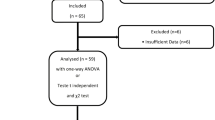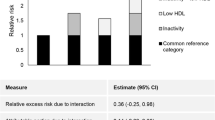Abstract
Background and aims: Increased plasma total homocysteine (Hcy) is a known cardiovascular disease (CVD) risk factor, related to several components of the established CVD risk profile. Observational studies support the role of modifying life-style related risk factors such as diet, physical activity and alcohol consumption in CVD prevention. Regular physical activity protects against coronary artery disease, possibly through its role in controlling risk factors such as hypertension, diabetes mellitus and obesity, but also independently. The aim of our study was to test the hypothesis that there is an association between physical activity, life-style habits and plasma Hcy levels in an elderly population. Methods: In this cross-sectional study, 423 males and females aged 69.0±6.7 years completed an interview and laboratory examinations. Our main outcome measure was plasma levels of Hcy. Results: Mean Hcy values were 10.5±5.5 μmol/L (11.4±6.1 for males and 9.3±4.5 for females; p<0.001). Smoking and BMI were not found to be associated with Hcy levels. Physically active subjects, as well as B vitamin supplement users, had significantly lower Hcy levels (p=0.002 and p=0.004, respectively). In a multiple linear regression model, the Hcy level was 10% higher amongst participants with a sedentary life-style, 17% higher amongst males, 1% higher for each one-year increment in age, and 10% higher amongst participants who used no B vitamin supplements. Conclusions: Any level of physical activity was found to be an independent life-style habit associated with a lower Hcy level in an elderly population. This study supports existing recommendations for elderly persons to maintain a physically active life-style.
Similar content being viewed by others
References
El-Khairy L, Ueland PM, Nygard O, Refsum H, Vollset SE. Lifestyle and cardiovascular disease risk factors as determinants of total cysteine in plasma: the Hordaland Homocysteine Study. Am J Clin Nutr 1999; 70: 1016–24.
Jensen OK. Ingerslev J. Increased p-homocysteine — a risk factor for thrombosis. Ugeskr Laeger 1998; 160: 4405–10.
Nygard O, Vollset SE, Refsum H, et al. Total plasma homocysteine and cardiovascular risk profile. The Hordaland Homocysteine Study. JAMA 1995; 274: 1526–33.
Gariballa SE. Nutritional factors in stroke. Br J Nutr 2000; 84: 5–17.
Gudnason V, Stansbie D, Scott J, Bowron A, Nicaud V, Humphries S. C677T (thermolabile alanine/valine) polymorphism in methylenetetrahydrofolate reductase (MTHFR): its frequency and impact on plasma homocysteine concentration in different European populations. EARS group. Atherosclerosis 1998; 136: 347–54.
Simon J, Mayer O Jr, Rosolova H. Effect of folates, vitamin B12 and life style factors on mild hyperhomocysteinemia in a population sample. Cas Lek Cesk 1999; 138: 650–3.
Modan M, Halkin H, Almog S, et al. Hyperinsulinemia: A link between hypertension obesity and glucose intolerance. J Clin Invest 1985; 75: 809–17.
Jacobsen DW, Gatautis VJ, Green R, et al. Rapid HPLC determination of total homocysteine and other thiols in serum and plasma: sex differences and correlation with cobalamin and folate concentrations in healthy subjects. Clin Chem 1994; 40: 873–81.
Nygard O, Refsum H, Ueland PM, et al. Coffee consumption and plasma total homocysteine: the Hordaland Homocysteine Study. Am J Clin Nutr 1997; 65: 136–43.
de Bree A, Verschuren WM, Blom HJ, Kromhout D. Lifestyle factors and plasma homocysteine concentrations in a general population sample. Am J Epidemiol 2001; 154: 150–4.
Saw SM, Yuan JM, Ong CN, et al. Genetic, dietary and other lifestyle determinants of plasma homocysteine concentrations in middle-aged and older Chinese men and women in Singapore. Am J Clin Nutr 2001; 73: 232–9.
Ward M, McNulty H, McPartlin J, Strain JJ, Weir DG, Scott JM. Plasma homocysteine, a risk factor for cardiovascular disease, is lowered by physiological doses of folic acid. Quart J Med 1997; 90: 519–24.
Zamboni M. Francesco VD. Zoico E. et al. Homocysteine and lifestyle in the elderly. Aging Clin Exp Res 2001; 13: 437–42.
Bar On B, Kidron M, Friedlander Y, et al. Plasma total homocysteine levels in subjects with hyperinsulinemia. J Intern Med 2000; 247: 287–94.
Osganian SK, Stampfer MJ, Spiegelman D, et al. Distribution of and factors associated with serum homocysteine levels in children: child and adolescent trials for cardiovascular health. JAMA 1999; 281: 1189–96.
Lim S, Kim MS, Park KS, et al. Correlation of plasma homocysteine and mitochondrial DNA content in peripheral blood in healthy women. Atherosclerosis 2001; 158: 399–405.
Mennen LI, de Courcy GP, Guilland J-C, et al. Relation between homocysteine concentrations and the consumption of different types of alcoholic beverages: the French Supplementation with Antioxidant Vitamins and Minerals Study. Am J Clin Nutr 2003; 78: 334–8.
Ruskin PE, Blumstein Z, Walter-Ginzburg A, et al. Depressive symptoms among community-dwelling oldest-old residents in Israel. Am J Geriatr Psychiatry 1996; 4: 208–17.
Seligsohn U. Zivelin A. Thrombophilia as a multigenic disorder. Thromb Haemost 1997; 78: 297–301.
Author information
Authors and Affiliations
Corresponding author
Rights and permissions
About this article
Cite this article
Dankner, R., Chetrit, A., Lubin, F. et al. Life-style habits and homocysteine levels in an elderly population. Aging Clin Exp Res 16, 437–442 (2004). https://doi.org/10.1007/BF03327398
Received:
Accepted:
Published:
Issue Date:
DOI: https://doi.org/10.1007/BF03327398




